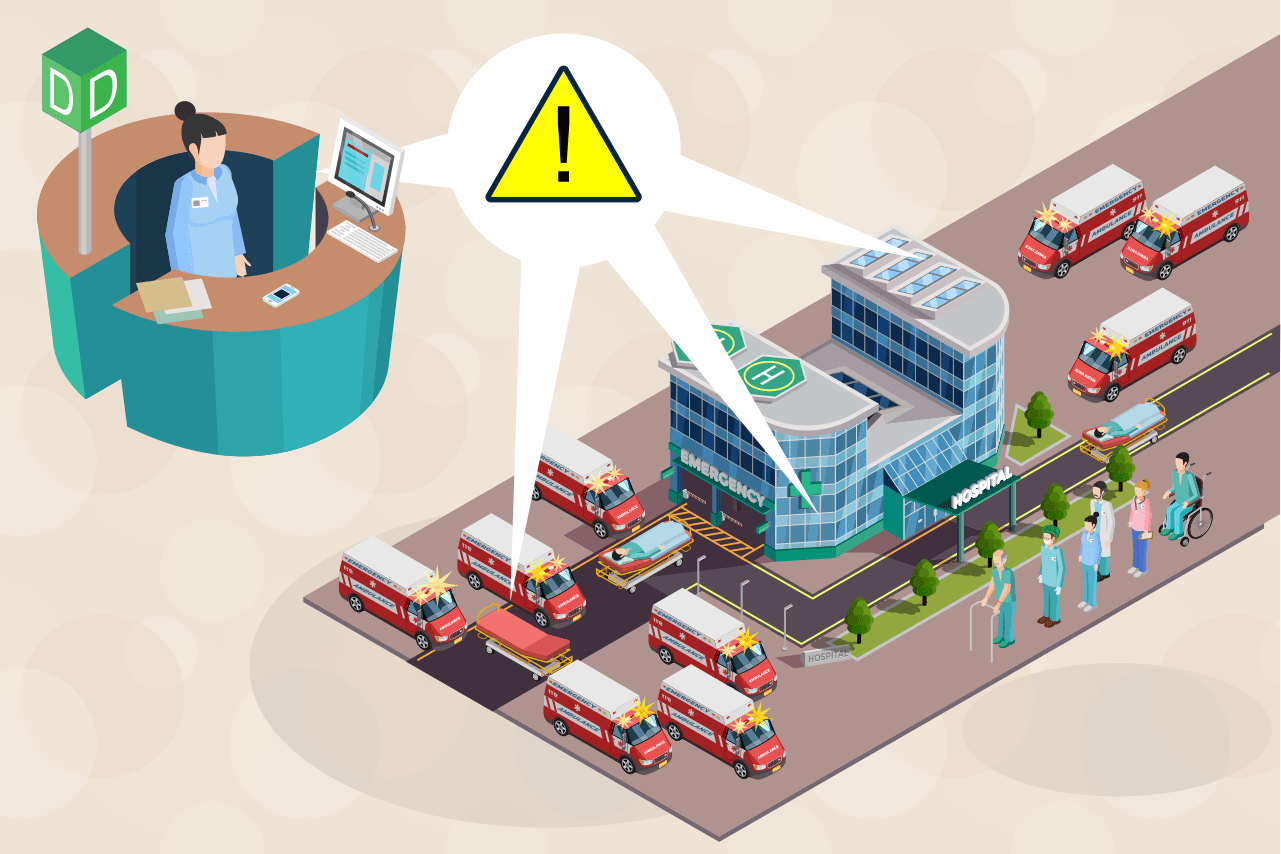
WHAT IS THE CULTURE OF SAFETY IN HEALTHCARE?
Ensuring safety in healthcare settings is more than a regulatory requirement; it's a foundational aspect of high-quality care that benefits everyone involved. When healthcare providers emphasize safety, they create an environment where risks are minimized, and patients can trust that their well-being is the top priority.
A culture of safety is the bedrock upon which patient-centered care is built, affecting every interaction and procedure within a healthcare facility. It involves a systematic approach where safety principles are integrated into every aspect of the healthcare process, from administrative tasks to patient care practices.
A culture of safety in healthcare is an environment where safety is a shared value and priority for all, from frontline staff to executive leadership. It is a comprehensive approach that requires constant vigilance, commitment to excellence, and a proactive stance on preventing harm.
In such a culture, every member of the healthcare team is empowered to speak up about risks and work collaboratively to resolve them. This approach ensures that the safety and well-being of patients and staff are always at the forefront of healthcare delivery.
BENEFITS OF SAFETY IN HEALTHCARE
Fostering a culture of safety leads to significant benefits for both patients and healthcare providers. It reduces the incidence of medical errors, decreases the likelihood of workplace injuries, and promotes a more positive working environment, which can lead to higher staff retention rates.
Moreover, a strong safety culture can improve patient outcomes, enhance the level of trust patients have in their healthcare providers, and can even contribute to the financial stability of healthcare institutions by avoiding the costs associated with preventable errors and accidents.
WHY IS THE CULTURE OF SAFETY IN HEALTHCARE IMPORTANT?
The significance of instilling a culture of safety within healthcare is paramount, as it forms the backbone of patient trust and care quality. It's a proactive safeguard against the risk of errors and a catalyst for open dialogue about continuous improvement in patient care.
Such a culture is crucial because it encourages a learning environment where mistakes are not feared but are seen as opportunities for growth and enhanced patient safety protocols.
Moreover, a well-established safety culture is vital for healthcare staff, providing them with the confidence and support needed to deliver the highest standard of care while ensuring their own safety.
Ultimately, it leads to better health outcomes, bolsters community trust in healthcare systems, and aligns with the ethical responsibility of healthcare providers to do no harm.
Improve Safety Culture with Real-World Communication Solutions
Struggling with communication gaps, safety risks, or operational inefficiencies?
Download our free guide, 8 Real-World Healthcare Use Cases, and discover how healthcare teams communicate faster and safer with DeskAlerts.

СHARACTERISTICS OF HEALTHCARE STAFF AND PATIENT SAFETY CULTURE INCLUDE:
Creating a culture of safety within healthcare organizations is a multi-faceted endeavor that requires commitment across all levels of staff. It's about nurturing an ecosystem where safety protocols are not just followed but are ingrained in the daily routine of healthcare providers.
This culture is sustained by a set of core characteristics that are both observable and measurable. They serve as the pillars upon which the trust between patients and healthcare providers is built and are critical for the smooth, safe operation of any healthcare facility.
MAIN CHARACTERISTICS OF A HEALTHCARE STAFF AND PATIENT SAFETY CULTURE INCLUDE:
- Open Communication About Safety Concerns
A transparent atmosphere where staff members feel comfortable reporting risks without fear of penalty is crucial. It ensures that potential issues can be addressed before they escalate into actual harm.
- A Non-Punitive Approach to Error Reporting
When staff members can report errors or near misses without retribution, it cultivates an environment of trust and learning rather than blame, which is essential for improving patient safety.
- Continuous Learning and Improvement
The healthcare field is ever-evolving, and a culture that prioritizes ongoing education and adaptation to new safety practices is key to maintaining high standards of patient care.
- Leadership Committed to Safety
Effective safety culture is often driven from the top; when leaders demonstrate a genuine commitment to safety, it sets the tone for the entire organization to follow suit.
- Teamwork Towards Common Safety Goals
Safety is a team sport in healthcare, requiring coordinated efforts from all staff members to ensure that safety protocols are effectively implemented and followed.
5 STEPS TO CREATE A STRONG SAFETY CULTURE IN YOUR HEALTHCARE ORGANIZATION
Building a strong safety culture within a healthcare organization is a dynamic and strategic process that involves systematic changes to behaviors and practices. It demands an unwavering commitment to safety from every level of the organization, from the boardroom to the bedside. These steps are not one-time initiatives but part of an ongoing journey towards excellence in healthcare delivery. By following these steps, healthcare organizations can develop a robust culture of safety that is reflected in every action they take and decision they make. This commitment not only enhances the quality of patient care but also ensures a safe working environment for healthcare professionals.
STEP 1: IMPROVE COMMUNICATION
Clear and Open Channels: Establishing open lines of communication across all departments ensures that concerns and ideas regarding patient safety can be shared freely and without fear. This includes regular meetings, safety briefings, and feedback mechanisms that encourage dialogue and the sharing of best practices.
STEP 2: INTRODUCE SOUND INCIDENT REPORTING SYSTEMS
Reliable Reporting Mechanisms: A strong safety culture is underpinned by a system that allows staff to report incidents or near misses without blame. This system should be user-friendly and accessible, ensuring that every member of the team can contribute to the safety dialogue.
STEP 3: HAVE LEADERSHIP MODEL THE BEHAVIORS YOU WANT TO ENCOURAGE
Lead by Example: Leadership should actively demonstrate their commitment to safety, setting a precedent for the rest of the staff. They must walk the walk by adhering to safety protocols and recognizing staff who do the same.
STEP 4: KEEP AN EYE ON EMERGING SAFETY ISSUES
Proactive Risk Management: Staying informed about new risks and integrating this knowledge into safety planning is vital. This may involve subscribing to safety alerts, conducting regular risk assessments, and training staff to recognize and respond to new hazards.
STEP 5: ACTIVELY INVEST IN SAFETY
Resource Allocation: Investing in the right tools, training, and staff to enhance safety is a clear indicator of an organization’s commitment to creating a culture of safety. This includes regular updates to equipment, continuous professional development opportunities for staff, and dedicating financial resources to safety improvements.
See How Leading Hospitals Put These Steps Into Action
You've just learned the 5 essential steps to build a strong safety culture. Now see how real healthcare organizations are already doing it.
Download our free guide, 8 Real-World Use Cases: How Healthcare Teams Communicate Faster and Safer with DeskAlerts.
You’ll discover:
- How hospitals reduce communication errors
- Ways teams coordinate care more safely
- Use cases aligned with safety culture best practices

PROMOTING A CULTURE OF SAFETY IN HEALTHCARE
Promoting a culture of safety in healthcare is an ongoing process that extends beyond the implementation of policies and procedures.
It involves engaging every member of the healthcare team, from administrators to frontline workers, in a shared vision of preventing harm and continuously improving care. This collective effort can lead to a transformative shift in the healthcare environment, where safety becomes an intrinsic part of the organizational fabric.
By actively promoting safety practices, healthcare organizations can foster an environment where the well-being of patients and staff is always the primary focus. Below are strategic ways to embed this culture deeply within the organization.
WAYS TO PROMOTE A CULTURE OF SAFETY IN HEALTHCARE
- Creating Internal Marketing Campaigns
Engagement and Awareness: Utilizing internal marketing campaigns can effectively promote the principles of safety within the healthcare setting. These campaigns should aim to engage staff at all levels with compelling messages and reminders about safety protocols and the importance of reporting and preventing errors.
- Letting People Know When There's a Safety Issue
Transparency and Responsiveness: When safety issues arise, addressing them openly and promptly is key. Informing all stakeholders of existing safety concerns not only aids in immediate rectification but also helps in preventing similar future incidents.
- Providing Appropriate Training
Education and Competence: Regular and comprehensive training programs ensure that all healthcare personnel have the necessary knowledge and skills to maintain safety standards. This training should be tailored to the roles and responsibilities of different staff members and updated regularly to reflect the latest safety protocols and best practices.
- Testing Employees' Knowledge of Safety
Assessment and Reinforcement: Periodic testing of employees’ understanding of safety procedures is crucial for reinforcing the culture of safety. It ensures that the knowledge imparted during training is retained and applied correctly in daily practices, thus cementing a culture of safety within the organization.
FREQUENTLY ASKED QUESTIONS
WHAT ARE 5 SAFETY CONCERNS IN HEALTHCARE?
- Infection Control: Preventing the spread of infections, including healthcare-associated infections (HAIs), through stringent hygiene practices and protocols.
- Medication Errors: Ensuring accurate prescribing, dispensing, and administering of medications to prevent errors that can lead to patient harm.
- Patient Falls: Implementing measures to prevent falls within healthcare facilities, which can result in serious injuries, particularly for vulnerable populations like the elderly.
- Staff Injuries: Protecting healthcare workers from potential injuries, including needlestick injuries, back injuries from lifting and moving patients, and exposure to hazardous substances.
- Equipment-Related Hazards: Regularly maintaining and correctly using medical equipment to prevent malfunctions or accidents that could endanger patients or staff.
WHY IS A CULTURE OF SAFETY IMPORTANT IN HEALTHCARE?
A culture of safety is pivotal in healthcare as it directly correlates to the quality and effectiveness of patient care. It fosters an environment where safety is a reflex, not an afterthought, leading to reduced errors, enhanced patient outcomes, and improved staff morale and retention.
A strong safety culture encourages reporting and transparency, which facilitates learning from incidents and near-misses.
Tools like DeskAlerts can be instrumental in promoting such a culture by providing a platform for instant communication of safety alerts and educational materials across an organization.
WHAT ARE THE 3 MAJOR SAFETY CONCERNS FOR HEALTHCARE WORKERS?
- Exposure to Diseases and Infections: Healthcare workers are at risk of exposure to various pathogens, including multi-drug-resistant strains of bacteria and viruses, such as COVID-19.
- Workplace Violence: Incidents of violence or aggression from patients or visitors pose a significant risk to healthcare workers.
- Burnout and Stress: The high-pressure environment of healthcare can lead to mental and physical exhaustion, reducing the ability to maintain safety standards and increasing the risk of errors.
WHAT ARE THE PRINCIPLES OF SAFETY IN HEALTHCARE?
The principles of safety in healthcare revolve around:
- Non-maleficence: Above all, do no harm. This principle is about avoiding harm to patients through careful risk assessment and management.
- Preparedness: Being ready to respond to safety issues promptly and effectively.
- Reporting and Transparency: Encouraging the reporting of errors or near-misses without fear of punishment, thereby fostering an environment of openness and continuous improvement.
- Education and Training: Ensuring all healthcare workers are adequately trained in the latest safety protocols and procedures.
- Continuous Improvement: Regularly evaluating and improving safety processes based on the latest evidence and feedback from safety incidents.
What are the 5 steps to change the safety culture in your organization?
Organizations looking at how to create a safety culture should start by implementing strategic steps to foster an environment where safety is prioritized at every level. Here are five key steps to initiate and sustain a positive shift in safety culture:
- Leadership commitment: Top management must actively demonstrate their commitment to safety by allocating resources, setting clear expectations, and leading by example.
- Open communication: Encourage staff to voice safety concerns without fear of retribution. Establishing channels for transparent communication promotes a culture of trust and collaboration.
- Comprehensive training: Provide ongoing training and education to equip staff with the knowledge and skills necessary to uphold safety standards and respond effectively to potential hazards.
- Regular safety audits: Conduct routine assessments to identify potential risks and areas for improvement. Regular audits help to proactively address safety issues before they escalate.
- Recognition and reward: Recognize and celebrate individuals and teams who demonstrate a commitment to safety. Positive reinforcement reinforces desired behaviors and motivates continued adherence to safety protocols and is an important step that shouldn’t be overlooked if you are looking at how to change safety culture.
How do you build a culture of safety in healthcare?
Creating a safety culture in healthcare begins with strong leadership commitment, fostering open communication channels where staff feel empowered to report concerns without fear of reprisal. Providing comprehensive training ensures that everyone understands safety protocols, while regular audits identify and address potential risks. Recognizing and rewarding safety-conscious behavior reinforces positive habits, creating an environment where patient and staff well-being are paramount priorities.
What are the key steps to a safe culture?
Key steps to fostering a safe workplace culture include: establishing leadership commitment to safety, promoting open communication channels for reporting concerns, providing thorough safety training, conducting regular safety audits, and recognizing and rewarding safety-conscious behavior. These steps create an environment where safety is prioritized, ensuring the well-being of employees and minimizing workplace hazards.
What are the elements of safety culture in healthcare?
When you’re looking at how to build a safety culture in healthcare, it’s important to take a multifaceted approach that encompasses various key elements:
- Top management must demonstrate a firm commitment to safety, actively championing and supporting safety initiatives.
- Establishing transparent communication channels.
- Empowering staff to voice safety concerns without fear of retribution.
- Providing thorough and ongoing training ensures that all personnel understand and adhere to safety protocols.
- Conducting routine assessments helps to identify potential risks and areas for improvement proactively.
- Involving patients in safety discussions and decision-making processes fosters a patient-centered approach to safety.
- Embracing a culture of continuous improvement to allow for the refinement of safety processes and procedures over time.
- Ensuring compliance with industry standards and regulatory requirements
- Encouraging teamwork and collaboration facilitates the sharing of best practices and promotes a collective responsibility for safety.
- Establishing mechanisms for feedback allows for ongoing evaluation and adjustment of safety initiatives based on input from frontline staff and stakeholders.
 Caroline Duncan
Caroline Duncan








